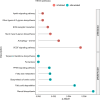Effects of eicosapentaneoic acid on innate immune responses in an Atlantic salmon kidney cell line in vitro
- PMID: 38805503
- PMCID: PMC11132502
- DOI: 10.1371/journal.pone.0302286
Effects of eicosapentaneoic acid on innate immune responses in an Atlantic salmon kidney cell line in vitro
Abstract
Studies of the interplay between metabolism and immunity, known as immunometabolism, is steadily transforming immunological research into new understandings of how environmental cues like diet are affecting innate and adaptive immune responses. The aim of this study was to explore antiviral transcriptomic responses under various levels of polyunsaturated fatty acid. Atlantic salmon kidney cells (ASK cell line) were incubated for one week in different levels of the unsaturated n-3 eicosapentaneoic acid (EPA) resulting in cellular levels ranging from 2-20% of total fatty acid. These cells were then stimulated with the viral mimic and interferon inducer poly I:C (30 ug/ml) for 24 hours before total RNA was isolated and sequenced for transcriptomic analyses. Up to 200 uM EPA had no detrimental effects on cell viability and induced very few transcriptional changes in these cells. However, in combination with poly I:C, our results shows that the level of EPA in the cellular membranes exert profound dose dependent effects of the transcriptional profiles induced by this treatment. Metabolic pathways like autophagy, apelin and VEGF signaling were attenuated by EPA whereas transcripts related to fatty acid metabolism, ferroptosis and the PPAR signaling pathways were upregulated. These results suggests that innate antiviral responses are heavily influenced by the fatty acid profile of salmonid cells and constitute another example of the strong linkage between general metabolic pathways and inflammatory responses.
Copyright: © 2024 Gjøen et al. This is an open access article distributed under the terms of the Creative Commons Attribution License, which permits unrestricted use, distribution, and reproduction in any medium, provided the original author and source are credited.
Conflict of interest statement
The authors have declared that no competing interests exist.
Figures








Similar articles
-
Effect of eicosapentaenoic acid on innate immune responses in Atlantic salmon cells infected with infectious salmon anemia virus.Virol J. 2025 Jan 9;22(1):5. doi: 10.1186/s12985-024-02619-0. Virol J. 2025. PMID: 39780168 Free PMC article.
-
Transcriptome profiling of antiviral immune and dietary fatty acid dependent responses of Atlantic salmon macrophage-like cells.BMC Genomics. 2017 Sep 8;18(1):706. doi: 10.1186/s12864-017-4099-2. BMC Genomics. 2017. PMID: 28886690 Free PMC article.
-
The dietary replacement of marine ingredients by terrestrial animal and plant alternatives modulates the antiviral immune response of Atlantic salmon (Salmo salar).Fish Shellfish Immunol. 2017 May;64:24-38. doi: 10.1016/j.fsi.2017.02.040. Epub 2017 Feb 24. Fish Shellfish Immunol. 2017. PMID: 28242361
-
Interaction between dietary fatty acids and genotype on immune response in Atlantic salmon (Salmo salar) after vaccination: A transcriptome study.PLoS One. 2019 Jul 31;14(7):e0219625. doi: 10.1371/journal.pone.0219625. eCollection 2019. PLoS One. 2019. PMID: 31365530 Free PMC article.
-
Liver Transcriptome Profiling Reveals That Dietary DHA and EPA Levels Influence Suites of Genes Involved in Metabolism, Redox Homeostasis, and Immune Function in Atlantic Salmon (Salmo salar).Mar Biotechnol (NY). 2020 Apr;22(2):263-284. doi: 10.1007/s10126-020-09950-x. Epub 2020 Feb 10. Mar Biotechnol (NY). 2020. PMID: 32040779
Cited by
-
Effect of eicosapentaenoic acid on innate immune responses in Atlantic salmon cells infected with infectious salmon anemia virus.Virol J. 2025 Jan 9;22(1):5. doi: 10.1186/s12985-024-02619-0. Virol J. 2025. PMID: 39780168 Free PMC article.
References
-
- Ayres J. S., Immunometabolism of infections. Nat Rev Immunol 2020, 20, (2), 79–80. - PubMed
-
- van den Hoogen B.; Santoni A.; Sciume G.; Bowie A.; O’Farrelly C.; O’Neill L.; et al.., Immunometabolism pathways as the basis for innovative anti-viral strategies (INITIATE): A Marie Sklodowska-Curie innovative training network. Virus Res 2020, 287, 198094. doi: 10.1016/j.virusres.2020.198094 - DOI - PMC - PubMed
MeSH terms
Substances
LinkOut - more resources
Full Text Sources
Research Materials

